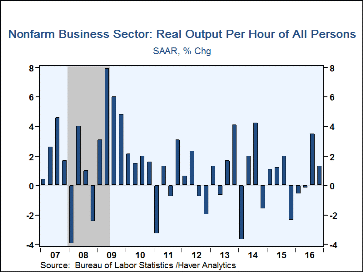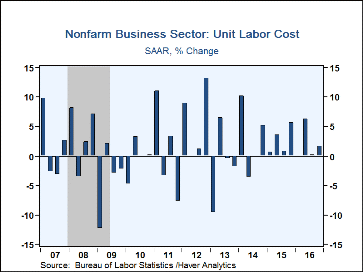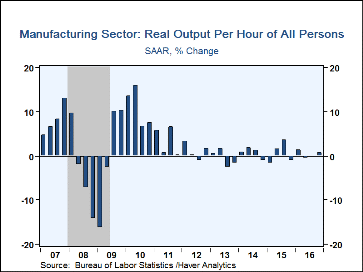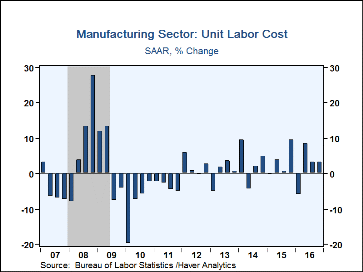 Global| Feb 02 2017
Global| Feb 02 2017U.S. Productivity Gain Moderates; Unit Labor Costs Pick Up
by:Tom Moeller
|in:Economy in Brief
Summary
Growth in nonfarm output per hour during Q4'16 increased at a 1.3% rate (1.0% y/y) following a 3.5% rise in Q3, revised from 3.1%. A 1.0% increase had been expected in the Action Economics Forecast Survey. These latest two increase [...]
Growth in nonfarm output per hour during Q4'16 increased at a 1.3% rate (1.0% y/y) following a 3.5% rise in Q3, revised from 3.1%. A 1.0% increase had been expected in the Action Economics Forecast Survey. These latest two increase followed three consecutive quarters of decline. During all of 2016, productivity increased 0.2%, the weakest rise since 2011. Output rose at a 2.2% rate (2.2% y/y) while hours-worked improved 0.9% (1.1% y/y). The gain in productivity was accompanied by a 3.0% increase in compensation, which was weaker than the 3.7% gain during Q3. The 2.9% y/y increase left it roughly equal to the gains during all of 2015 and 2014. Adjusted for price inflation, compensation fell 0.4% (+1.1% y/y). Unit labor costs increased 1.7% (1.9% y/y) following a 0.2% increase in Q3, revised from 0.7%. A 2.1% rise had been expected. During all of last year, unit labor costs increased 2.6%, the strongest gain since 2007.
In the manufacturing sector, productivity increased 0.7% (0.4% y/y) following no change in Q3, revised from 0.4%. During all of last year, productivity increased 0.6% after a 0.3% rise in 2015. Factory output rose 0.8% (0.2% y/y) and hours-worked remained steady (-0.2% y/y). Compensation improved at a 4.1% rate (2.6% y/y) following a downwardly revised 3.4% increase. The gain in compensation lifted unit labor costs by a steady 3.3% (2.2% y/y). During all of last year, unit labor costs increased 2.6%, up from the 2.2% gain in 2015.
The productivity & cost figures are available in Haver's USECON database. The expectations figures are from the Action Economics Forecast Survey and are found in the AS1REPNA database.
| Productivity & Costs (SAAR, %) | Q4'16 | Q3'16 | Q2'16 | Q4'16 Y/Y | 2016 | 2015 | 2014 |
|---|---|---|---|---|---|---|---|
| Nonfarm Business Sector | |||||||
| Output per Hour (Productivity) | 1.3 | 3.5 | -0.2 | 1.0 | 0.2 | 0.9 | 0.8 |
| Compensation per Hour | 3.0 | 3.7 | 6.1 | 2.9 | 2.8 | 2.9 | 2.8 |
| Unit Labor Costs | 1.7 | 0.2 | 6.2 | 1.9 | 2.6 | 2.0 | 2.0 |
| Manufacturing Sector | |||||||
| Output per Hour (Productivity) | 0.7 | 0.0 | -0.5 | 0.4 | 0.6 | 0.3 | 0.1 |
| Compensation per Hour | 4.1 | 3.4 | 8.0 | 2.6 | 3.3 | 2.5 | 2.8 |
| Unit Labor Costs | 3.3 | 3.3 | 8.5 | 2.2 | 2.6 | 2.2 | 2.7 |
Tom Moeller
AuthorMore in Author Profile »Prior to joining Haver Analytics in 2000, Mr. Moeller worked as the Economist at Chancellor Capital Management from 1985 to 1999. There, he developed comprehensive economic forecasts and interpreted economic data for equity and fixed income portfolio managers. Also at Chancellor, Mr. Moeller worked as an equity analyst and was responsible for researching and rating companies in the economically sensitive automobile and housing industries for investment in Chancellor’s equity portfolio. Prior to joining Chancellor, Mr. Moeller was an Economist at Citibank from 1979 to 1984. He also analyzed pricing behavior in the metals industry for the Council on Wage and Price Stability in Washington, D.C. In 1999, Mr. Moeller received the award for most accurate forecast from the Forecasters' Club of New York. From 1990 to 1992 he was President of the New York Association for Business Economists. Mr. Moeller earned an M.B.A. in Finance from Fordham University, where he graduated in 1987. He holds a Bachelor of Arts in Economics from George Washington University.










